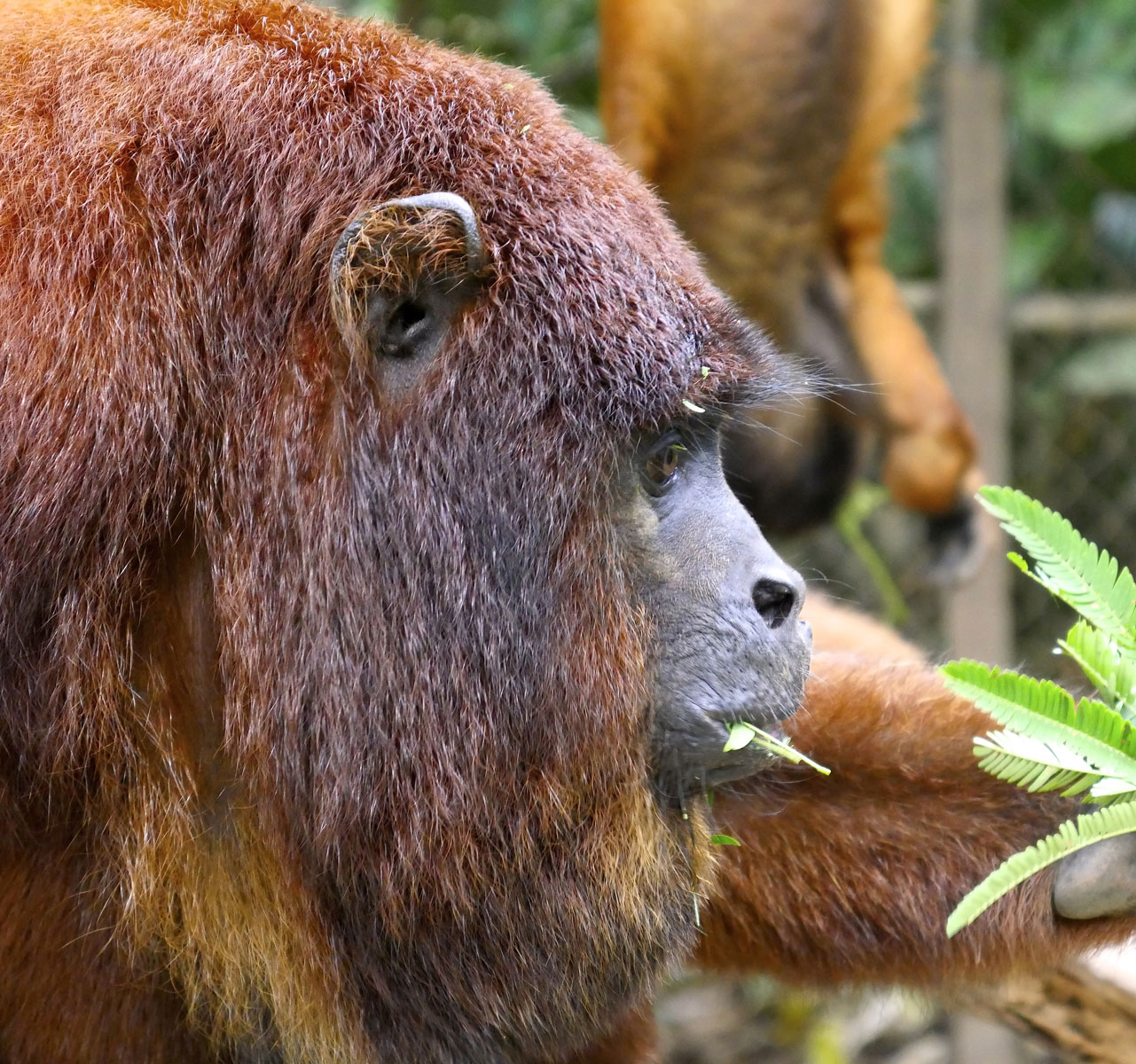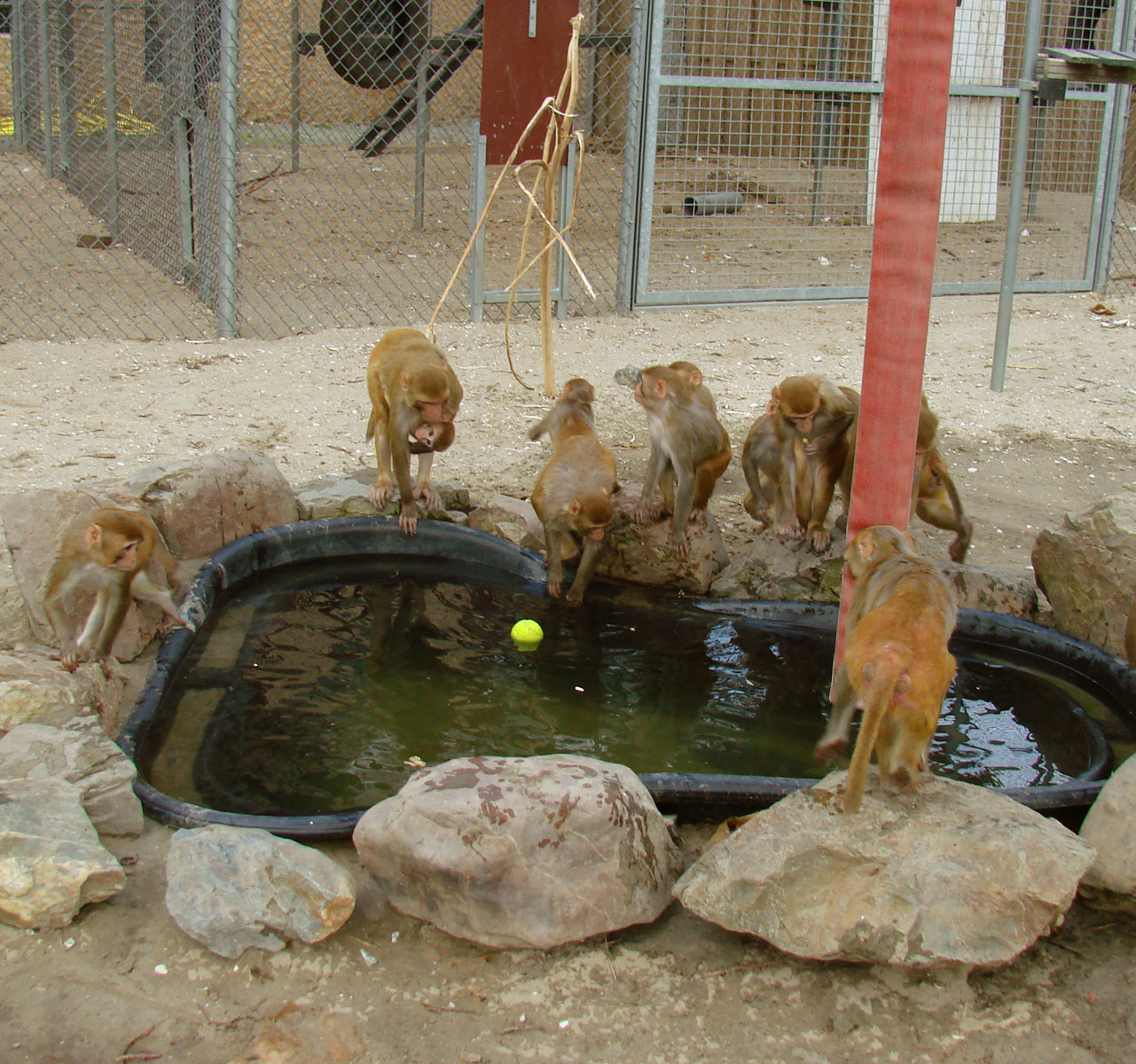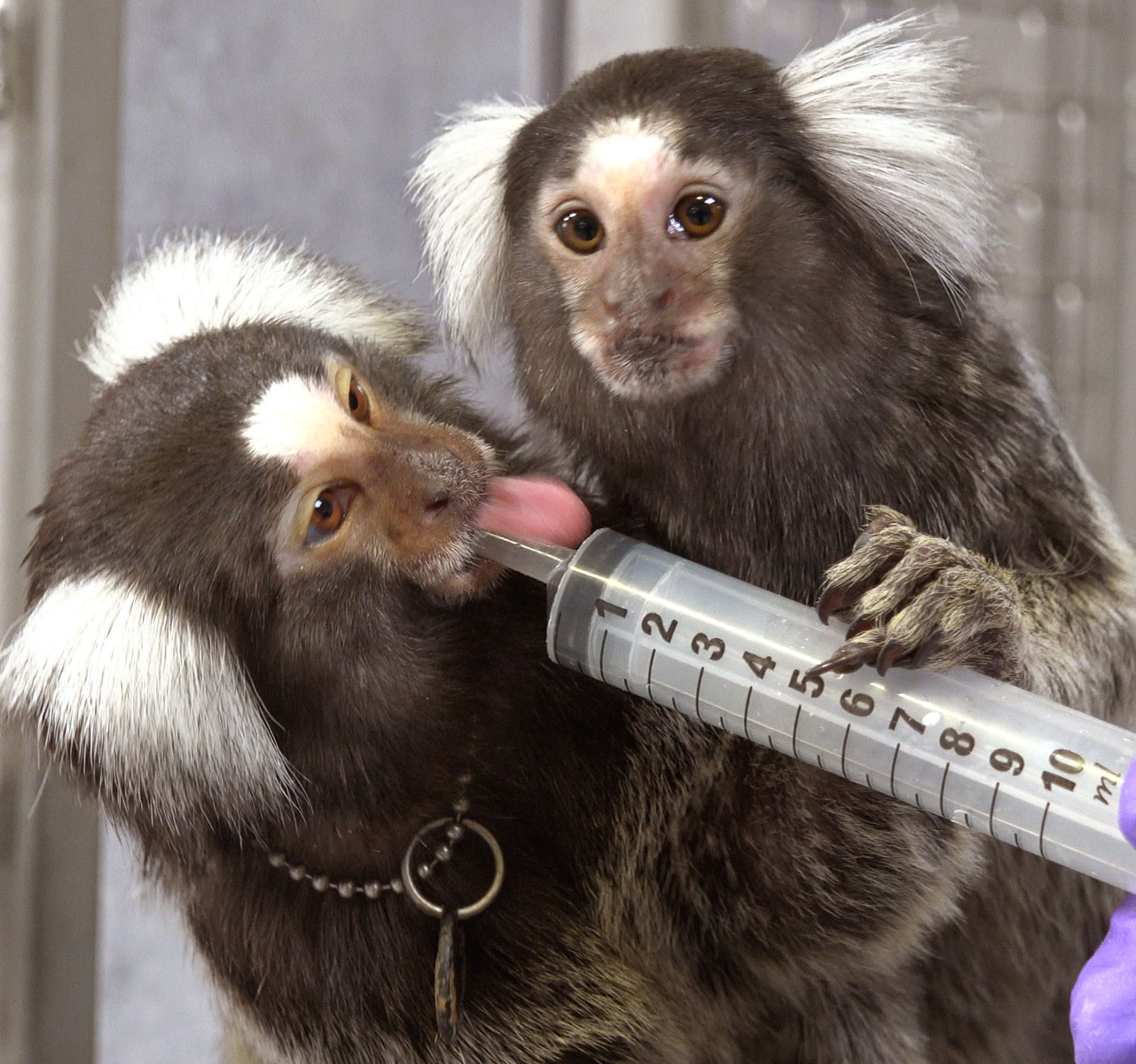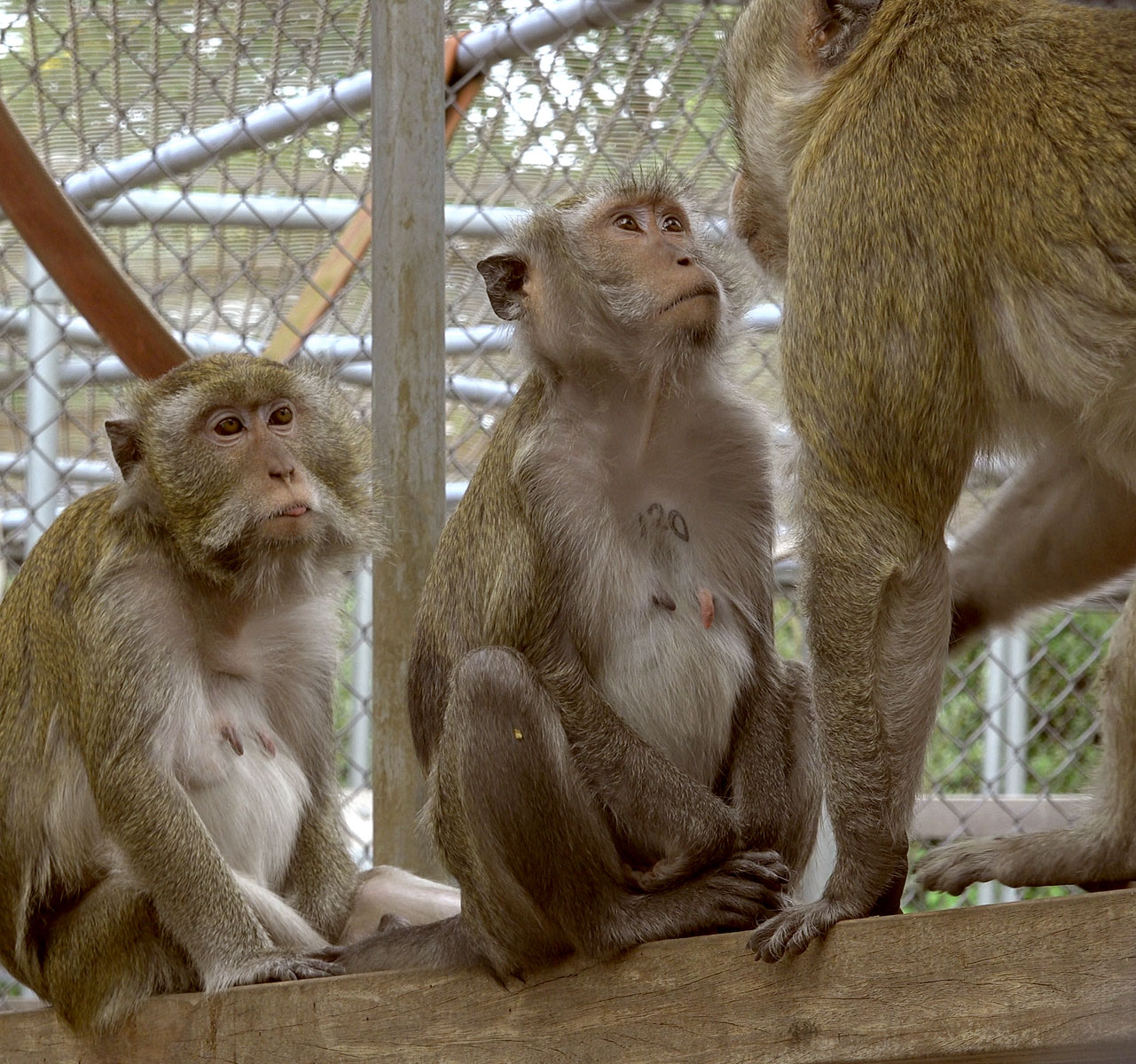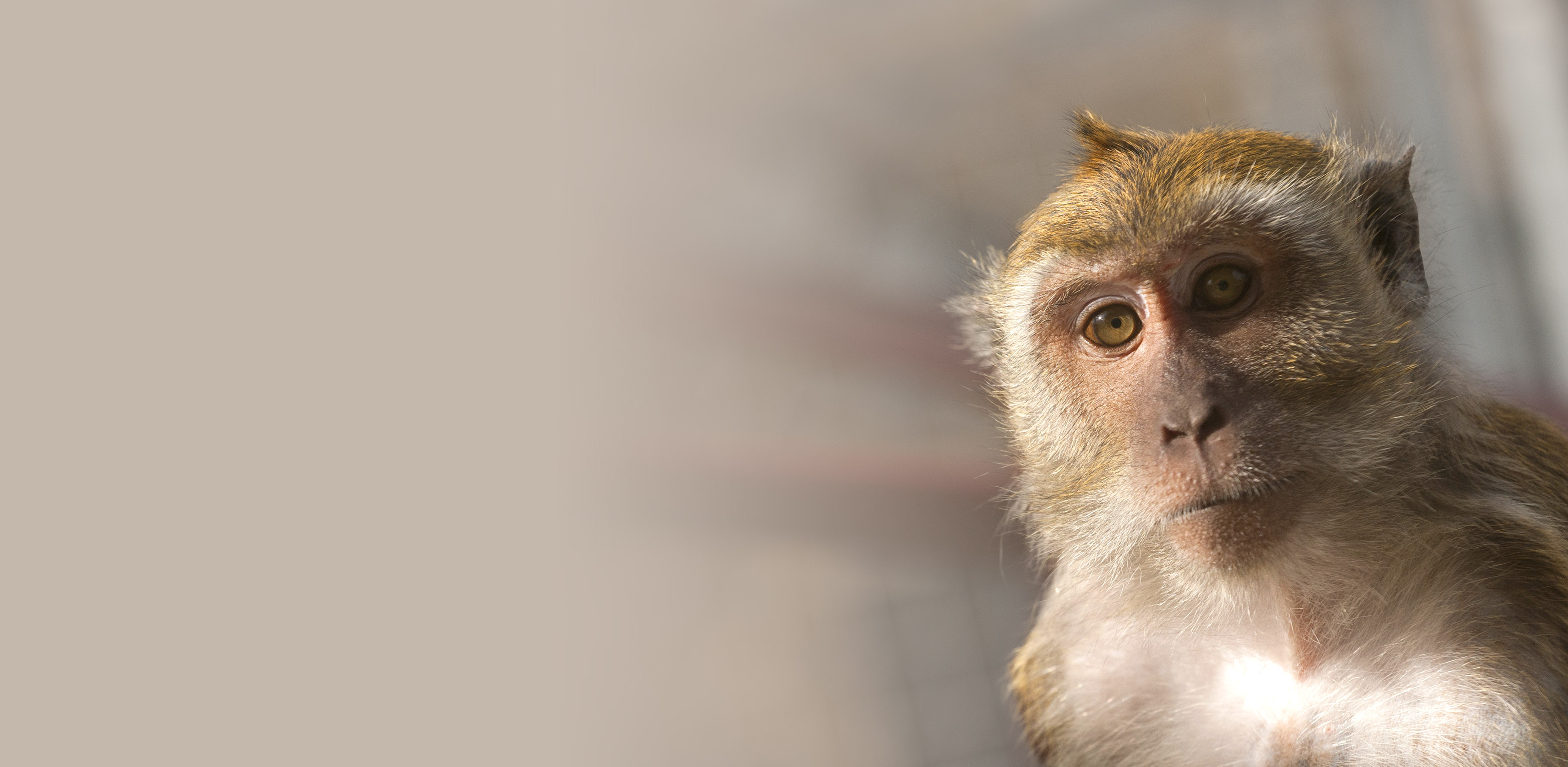
A few other things we would like you to know
We will be very happy to tell you about our working methods
-
Alternatives
The Biomedical Primate Research Centre (BPRC) is a science institute that conducts biomedical research on serious diseases, e.g. corona, AIDS, malaria, hepatitis, tuberculosis and aging diseases such as Parkinson's and Alzheimer. While conducting that research, we also do our utmost to develop research methods that do not involve any animal testing.
We all wish to conduct research that does not involve animal testing
Obviously, we are a primate research centre, and yes, we do work with animals. However, our main task is to conduct research, our primary goal being the resolution of medical problems. At present, we still need animals to do so, but if anyone comes up with a method allowing us to skip the animal testing, we will be extremely happy to use it. Unfortunately, we have not yet advanced far enough in the development of research methods that do not involve animal testing to be able to solve all the complex research issues we wish to solve without any form of animal testing.
Everybody wants to reduce the number of studies involving animal testing. We do, too. Our studies would be much cheaper, faster, easier and more flexible if they did not involve animals. For instance, we would be able to carry out many more simultaneous tests using culture systems. So even a primate research centre like BPRC, which values qualitative research, would like to conduct research that does not involve animal testing.
Promotion and support
At BPRC, research on the development of research methods that do not involve any animal testing has been partially assigned to a dedicated independent research group. In addition, BPRC promotes and supports the use of alternative methods in all its individual research units. We have always done so, as have our predecessors. Back in the mid-1990s, we were already receiving grants for the Alternatives to Animal Testing Platform. Some people think we would lose our raison d'être without monkeys. We may have to change our name if we ever lose our monkeys, but we will still be a research institute. Conducting research is our core business.
Reduction, refinement and replacement of experiments involving animal testing.
BPRC contributes to the development of new medications and therapies for serious diseases. In so doing, it operates in accordance with the principle of the three Rs: reduction, refinement and replacement of experiments involving animal testing. The principle of the three Rs basically amounts to our being able (thanks to new technologies and improved selection methods) to minimise the number of animals we need for testing purposes, and that we seek to make our monkeys' lives as pleasant as possible.
For instance, we seek to obtain more information from fewer animals, meaning we need fewer experimental animals (reduction). In addition, we expend a great deal of energy on identifying methods that will allow us to carry out research that does not require any animal testing (replacement). Furthermore, we pay a lot of attention to things such as ethological research, i.e., observation, which enables us to give our monkeys even better living conditions. This is an example of refinement.
The results we have obtained
BPRC has achieved many major feats in the field of research methods that do not involve animal testing, e.g. in the field of malaria research. Together with a French lab, we have established many culture techniques, which allow us to examine vital components of anti-malarial therapies in a Petri dish. We were the ones to develop this method of assessing therapies against a particular malaria parasite, and further development is ongoing
Culture techniques and genetic dissection
BPRC has developed culture techniques that allow us to use parasite models for malaria research. As a result, some studies now require fewer monkeys. In addition, we have established many culture techniques allowing us to culture brain tissue. This allows us to do the preliminary research on the effects of certain agents in a Petri dish – for instance, in a study designed to help combat MS. Furthermore, we are making progress in terms of genetic dissection of the animals' immune system, which allows us to make a more targeted selection of animals for experimentation purposes.
Vaccines
In order to activate the immune system more strongly, we often use adjuvants in humans and experimental animals. Unfortunately, adjuvant injections often come with adverse reactions, such as inflammation of the skin at the injection site. BPRC endeavours to develop new adjuvants in several ways, in hopes of creating adjuvants that potentiate immune responses in the same way, but with fewer or no side-effects.
Batch-testing
With respect to more efficient research methods, the development of batch-testing is an interesting trend. Officially, the efficacy of a new batch of vaccines must still be tested in animals. Thanks to this new concept, a batch (collection) of approved vaccines may serve as a model for new batches through so-called cellular assays, meaning we won't have to get new animals involved each time we create a batch. BPRC, in association with several other Dutch research institutes, is involved in the further development of this concept.
We are currently conducting experiments to determine whether it is possible to use so-called in-vitro techniques rather than animals, the main objective being having to use fewer animals for this type of work – not just for research focusing on a specific disease, but in general.
The more alternative methods we come up with, the better
It should be noted here that the development of alternative methods, however important, is a highly complex and time-consuming process. People often ask us, ‘Surely you can do that using a computer?’. No, we can't. If we could, we would be doing it right now. We want to use fewer animals as much as everyone else does. For this reason, we expend a great deal of energy and time on the development of research methods that do not involve animal testing, and we contribute to the implementation of alternative methods elsewhere. The more alternative methods we come up with, the better. However, for the time being, complete replacement of animal testing remains a time-consuming process.
-
Quality of life
The Biomedical Primate Research Centre (BPRC) has an excellent reputation in the field of expertise, colony management, housing and care for its animals. We apply sophisticated methods to minimise the discomfort experienced by the animals to the maximum extent possible, and we have a transparent policy with regard to animal welfare, because we feel that our monkeys deserve the best possible quality of life.
Quality of life
BPRC accommodates three types of monkeys: rhesus macaques, crab-eating macaques and marmosets. The majority of our animals are part of a breeding programme and are not used for experimentation purposes. The great majority of our animals are rhesus macaques (Macaca mulatta).
Each of these monkeys is highly valuable to us, as we obtain information from them. Therefore, they deserve the very best quality of life!
Born and bred at BPRC
All rhesus and crab-eating macaques and marmosets living at BPRC were born and bred at BPRC. While this breeding programme is expensive, it renders stressful transportation from breeding centres in countries such as China or Mauritius unnecessary. Occasionally we will buy a few monkeys from other specialist breeding centres when, in exceptional cases, we need more monkeys of a particular type than we have bred ourselves. We NEVER purchase monkeys that were caught in the wild, and we strictly observe all applicable European laws. We do very occasionally sell monkeys, but on a very limited scale, and only to research centres whose methods we know and understand – i.e., centres which meet all our research method requirements, and which uphold the highest animal welfare standards.
Later generations
Pursuant to European law, starting from 2022, all primates deployed for biomedical research must belong to generation F2 or later. This means they must be the second generation to be born in a breeding colony. The young of primates born in the wild belong to the F1 generation. F2 is the next generation. At BPRC have have much later generations, perhaps as late as the ninth or tenth generation. We do not have a single F0 monkey. We do still have a few F1 monkeys, as rhesus macaques can live up to thirty years. The few older monkeys we have – mostly females – live in natural groups and are not used for experimentation purposes. They are enjoying retirement. Actually, many of our animals spend their entire lives in breeding colonies, but that is a story that will be told elsewhere.
Living conditions
We perform experiments on animals to be able to combat life-threatening diseases worldwide. We contribute to the development of vaccines, medications and expertise, but we do ensure that the animals used in these experiments lead the best lives we can possibly give them. Our animals, born and bred to serve science, deserve the very best lives we can give them. We endeavour to give them good lives every day. We will continue, to the best of our ability, to give our animals pleasant lives for as long as animal testing continues to be necessary. We are clearly succeeding in doing so, given that our animal care workers have actually won awards ‘for their continued efforts to ensure that BPRC's monkeys have the best possible living conditions’.
Housing contributing to lives well lived
As we have mentioned, animal welfare is a priority to us. Our monkeys must be given as much room as they need to be themselves and move around freely. It is vital to us that they lead happy lives, which costs a considerable amount of money. In order to ensure that BPRC can properly look after its animals, BPRC receives an annual grant from the Ministry of Education, Culture and Science. It is partially thanks to this grant that we have been able to improve our animal homes tremendously. The large enclosures we have now were developed in consultation with animal protection groups and zoos. They were developed to help us accommodate the animals in the best possible way and provide them with the best possible living conditions.
Group enclosures for our breeding colonies
The outdoor enclosures are large cages in which the monkeys have plenty of room to move freely and play to their hearts' content. They are free to make up their own minds as to whether they wish to be outdoors or indoors. We warm their cages in winter, to different temperatures for each species. For instance, crab-eating macaques need warmer cages than rhesus macaques. In order to ‘enrich’ their lives, we give them many toys and pieces of equipment, such as fire hoses, roosts for them to sit on, monkey bars, slides, balls, trapezes and mirrors. Our employees collected these objects for our monkeys, or alternatively, they were donated (or sometimes purchased after the gift of a grant) by sports clubs, the fire brigade, municipal authorities, companies and animal protection associations.
Enclosures for monkeys used in experiments
We also ‘enrich’ the indoor enclosures inhabited by monkeys used in experiments. These monkeys have smaller enclosures, but they are never alone in a cage. We always put at least two monkeys together. These animals, too, are given all sorts of toys, which are rotated regularly. We pay a lot of attention to food enrichment (see below) for the monkeys living in this part of the centre, even more so than for monkeys living outdoors. They get something new every day.
Food enrichment items
Another major component of our policy is so-called ‘food enrichment’. This means that we offer animals who are subject to an experimental protocol something new every day, ranging from icecream to food puzzles. We described and explained all forms of environmental enrichment used at BPRC for the various species of monkeys in the Enrichment Manual for Macaques and Marmosets we drew up in association with EUPRIM-NET, a major EU project.
The very highest standards
Our animal accommodation methods conform to the very highest standards in the world. While monkeys used for experimentation purposes have less perfect lives than monkeys living in the breeding colony, we still seek to give them the very best (group) accommodation, and we encourage them to engage in natural behaviour, by offering them non-food enrichment. All animals have bedding at all times, in the form of sawdust or straw. They do not have to lie on chicken wire, and are encouraged to forage in their bedding. In short, we do everything in our power to give our monkeys the highest possible quality of life, no matter what their circumstances.
-
Selection
Not all of our monkeys are used in studies. In fact, most of them are not. Only about 10% of our monkeys will undergo testing in any given year. BPRC has a thorough selection process, in which the colony manager (an ethologist), veterinary physicians and geneticists closely cooperate. In this way, we ensure that our breeding programme is successful, prevent inbreeding and make sure that we select the best possible animals for our research projects
Selection
Non-human primates are approximately 93% genetically identical to humans. Monkeys are particularly similar to humans in terms of their immune system and brains. This also means that, just like humans, they are all individuals, with different personalities. For this reason, we assess each individual monkey for its suitability to particular types of tests. Many are found to be better suited to the breeding colony. Because all monkeys have different personalities, our animal care workers know exactly who is who.
For starters, our monkeys will never be under the age of 4 (rhesus and crab-eating macaques) or 1.5 (marmosets) before being considered for experimentation purposes.* The age at which the males leave their birth group partly depends on how quickly they mature. The sooner they are sexually mature, the sooner they are able to impregnate their half-sisters and others, which we are seeking to avoid.
* Marmosets are used for experimentation purposes at a younger age because their lifespan is shorter and they mature (and become sexually mature) at a younger age (age 1.5 to 2). Other than that, they have the same living conditions as our rhesus and crab-eating macaques, although they do live in smaller family groups: just parents with their offspring, who will often be twins.
Just like in the wild
Generally, young animals will remain in their birth group until they reach the aforementioned ages. These are the ages at which they would migrate to other groups if they were living in the wild. In this way we seek to imitate natural patterns to the maximum degree possible. This arrangement also entails that, just as with human beings, the young learn from their parents. This approach reduces the amount of anxiety experienced by the animals during experiments, since they are more mentally stable than animals which were removed from their birth group at an early age.
Male and female animals
When selecting animals, we make a sharp distinction between male and female monkeys. Female monkeys have a 50% chance of remaining in the breeding colony their entire lives, and of never being used for experimentation purposes. This is because they can spend their entire lives in a group and so can always be of value to the breeding group, which must be kept up and running. It should be noted that we may be able to use contraception in the near future, when we expect to need fewer animals.
BPRC has several rhesus macaque breeding groups, so that we only need a limited number of breeding males. Therefore, the majority of our male rhesus macaques are used in experiments. All young males are transferred from their breeding group to a separate enclosure, which they share with several other males. We keep them together for as long as possible.
Breeding or experiments
The colony manager serves as our behavioural expert (ethologist). In consultation with veterinary physicians and geneticists, s/he determines which animals are suitable for research and which are not, and for which particular studies they might be suitable. Some animals may be right for (a particular type of) research, but may be genetically more important to the breeding colony. At some point, the colony manager will decide whether such young males are better suited to being future breeding males, or whether they are better suited for experimentation purposes. If a young male is destined for breeding purposes, he will have to wait until age 7 or 8 at the earliest, or he will be unable to reproduce. After that he will be removed from his birth group and transferred to a different group (so as to prevent inbreeding), and at age 18 or so he will ‘retire’.
Experimental stage
Animals selected to be used in experiments are transferred to a different enclosure, where they will live in small groups of two to four same-sex monkeys. In these new enclosures, they are prepared with great love and care by our animal care workers for their further lives as experimental animals. They are provided with a great deal of enrichment to make their lives more pleasant, just like they were earlier in their birth groups.
Positive reinforcement
This preparation mainly consists of more intensive training. By that time, they will already have learned how to drink from a squeeze bottle, and now they will learn to do things such as opening their mouth, extending a hand or paw, and turning around. They will get a reward every time they do this – i.e., ‘positive reinforcement training’ (more on that in this story). Due to the duration of certain studies, the experimental stage may last several years. For this reason, we make sure that the animals do not stay in this environment for ever. Many of the monkeys will be euthanised in the end, for animal welfare reasons. Legislators check annually how many animals we have deployed for experimentation purposes.
Vet has final say
Needless to say, we do everything in our power to prevent our animals from suffering. When the animals are to be experimented upon, they receive general anaesthesia (in accordance with all the guidelines), and they are given analgesics to combat side-effects. But a lot is done before the animal gets to this stage, as well. In order to be granted permission to carry out a particular study, we must first estimate the amount of suffering, i.e. discomfort, an animal is likely to experience. We do our utmost to minimise the animal's level of discomfort. It should be noted that, when we conduct our studies, veterinary physicians have the final say on whether or not a study is to be continued. BPRC currently employs four vets, as well as a veterinary pathologist.
Animal welfare
The decision as to whether a particular animal can be used for experimentation purposes also depends on the animal's health status. BPRC frequently assesses its monkeys' health, both before and during tests. Animals undergo annual screening as a matter of course, and if they are found to be sick in any way, they will receive treatment and will not undergo experimentation. Animal welfare is our greatest priority. When an animal dies, we can store its usable organs and tissues for future or alternative studies (for more on that, read this story). For instance, we can use its liver to cultivate cells.
In this way, all the animals we accommodate, even the ones not used in experiments, are of tremendous value in the fight against serious diseases.
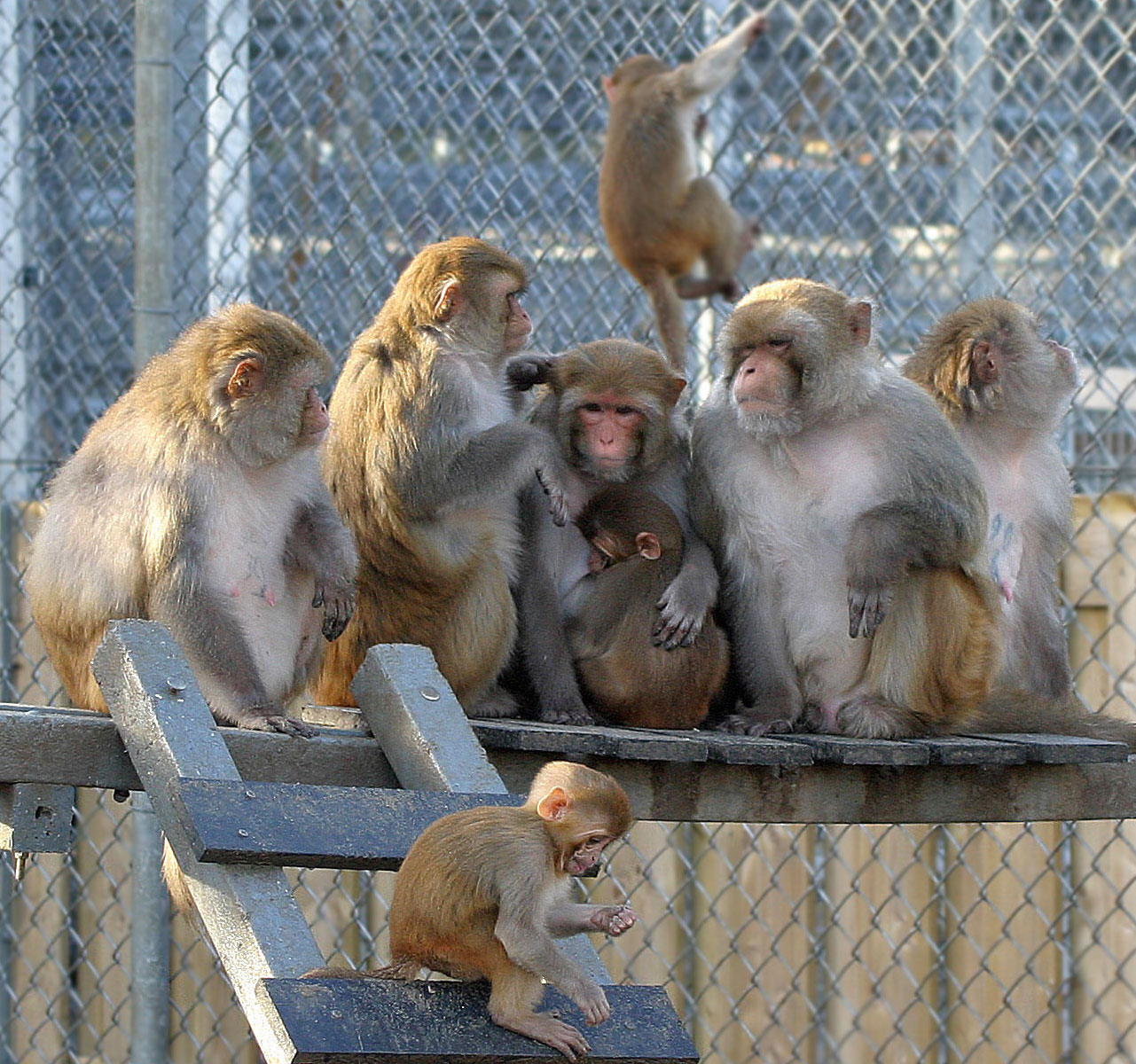
-
Biobank
BPRC's Biobank is Europe's largest repository of non-human primate tissue. Through the Biobank, we make our cells and tissues available to other researchers. It is a good example of international scientific research carried out in accordance with the highest ethical standards.
Biobank: bank with priceless collection
These are our freezers. They contain the treasures for researchers and other scientists from all over the world. These large units contain unique material that is of vital importance to researchers who carry out studies we cannot conduct ourselves.
In our freezers we store a wide range of biological materials, such as tissues, products derived from serum, blood, DNA, RNA and B cells. These materials are highly valuable to other research institutes, companies and organisations engaged in biomedical research. Researchers from all over the world are free to apply for certain materials, as long as they indicate what type of research they will need the materials for.
Rare and valuable primate specimens
In this way, BPRC makes rare and valuable primate specimens available to both BPRC employees and external scientists. Our Biobank may serve as an alternative source of information that will help people examine scientific hypotheses and pathomechanisms, and test new bioactive substances and biological products. The idea is to minimise the number of animals undergoing testing and to reduce research expenditures. We wish to emphasise here that our Biobank is NOT a commercial activity. We do not sell the cells and tissues we collect, but rather make them available to those who need them. We only expect to be reimbursed for the expenses we incur through storage and postage.
Biobank composition
Our Biobank is run by our veterinary pathologist, from where we literally mail our cells and tissues, several hundreds of times per year. Needless to say, we neatly categorise and label all our cells and tissues, and there are digital files on all the animals' backgrounds. This background information is essential, and is in fact what makes our Biobank unique – because our animals are born here and spend their entire lives here, we know everything there is to know about them. The veterinary pathologist decides what cells and tissues are suited to being stored in our Biobank and for what purposes.
Research groups
BPRC not only disseminates cells and tissues from its Biobank, but also shares them directly through various research groups. As is customary in the academic community, these research groups will make their data available for other purposes once they have been published in academic journals.
Visible results
Through its Biobank, BPRC indirectly contributes to several types of research. The cells and tissues we store are used in many studies. For instance, through our Biobank, we were involved in the characterisation of types of bacteria found in stomachs, and the oesophagi are used for diagnostic purposes.
Furthermore, we have helped (and still continue to help) others conduct many studies on the development of brains and brain functions – studies that are not always carried out at BPRC, but to which we do contribute through the cells and tissues we provide. The same is true for the use of our blood products, which are used by researchers investigating the cross-reactivity of certain medications, or the effects of certain medications on certain blood components. These researchers want to test these medications in a Petri dish before actually performing any experiments involving animals.
Significant contribution to science
The Biobank is physical evidence that all animals living at BPRC help advance the cause of science, even after they die, and even if they were never experimental animals in the first place. Because the cells and tissues we harvest after they die can still be used after their death. Which encourages us and others to conduct research that does NOT involve living animals!
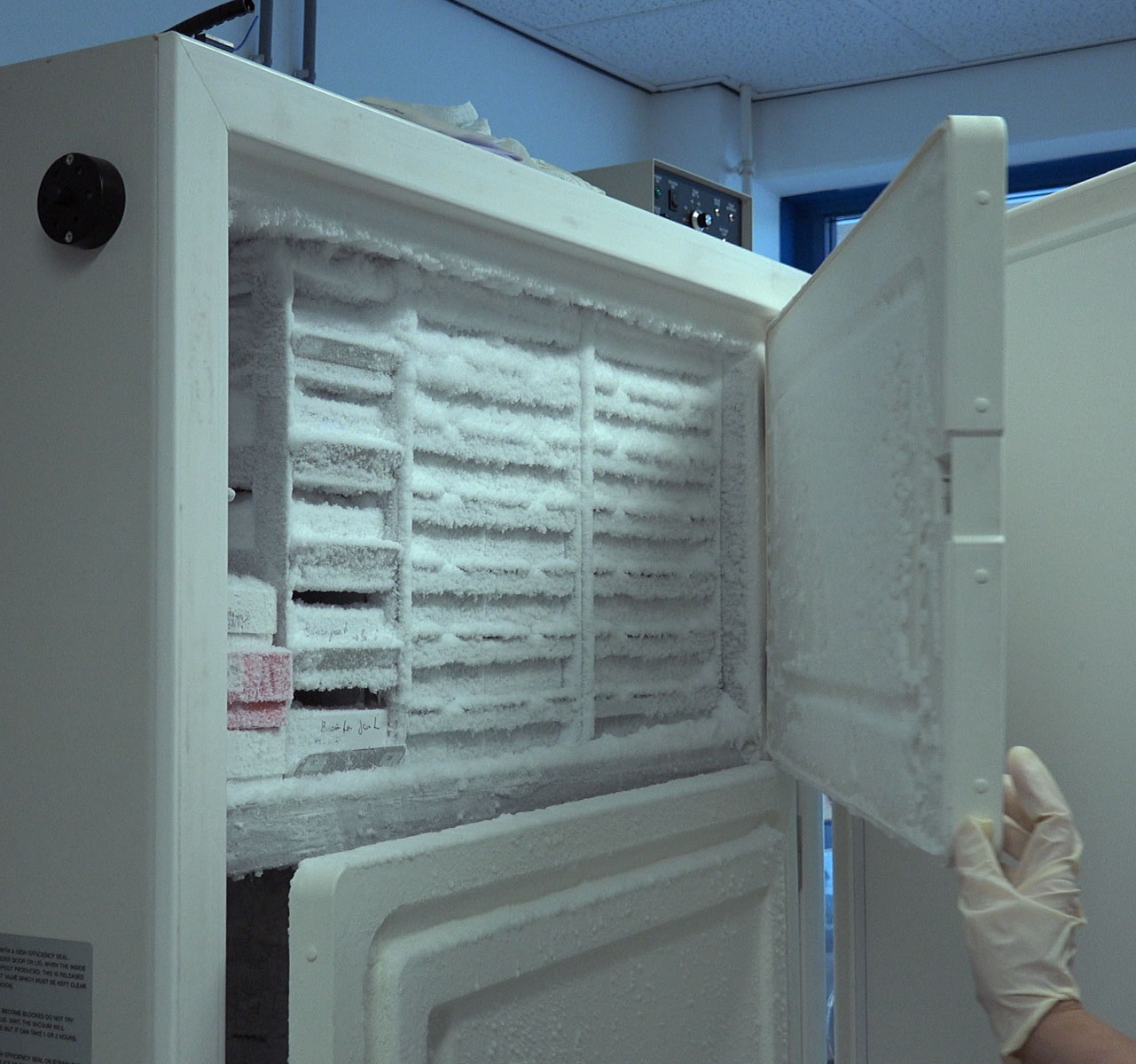
BPRC Bio-Bank; possibilities for researchers
Obtain material for biomedical research as well as for conservation studies.
Find out more -
Training
BPRC has engaged in animal training, designed to get to the animals to cooperate with scientists of their own accord, for quite a few years now. The objective of the training is to ensure that the experiments can be conducted in an easy and anxiety-free manner. This is beneficial both to animal welfare and to the research we carry out.
Life-long training
BPRC employs animal trainers whose only task is to train animals and further improve BPRC's enrichment methods. Training can be an important aspect of the process through which we select animals for our studies. Animals that learn quickly and prove cooperative are more likely to be chosen for participation in studies.
The main objective of the training we give the animals is to improve the animals' well-being and the quality of our research projects. To this end, BPRC's animal trainers always use innovative methods to ensure that the studies are conducted in the best possible manner.
Urgent wish to train animals properly
We have always focused on training our animals, but we have taken our training to a different level since 2008/2009, thanks mostly to our new social enclosures, both in the breeding colony and for experimental animals. Since we had an urgent wish to train our animals in such a way that they would agree to cooperate with our scientists of their own accord, we hired our first animal trainer. We now employ two animal trainers and some 28 animal care workers, some of whom know how to train monkeys, as well. Furthermore, our animal trainers are involved in international programmes designed to further develop these training methods. They share their expertise with other research institutes – for instance, by giving lectures or teaching workshops.
Voluntary cooperation
We use training methods designed to get our animals to cooperate with our researchers to the maximum extent possible, thus reducing the amount of anxiety they experience during the experiments. This positively affects both animal well-being and the quality of the studies we conduct. For example, thanks to our training methods, our animal care workers do not have to squeeze the animals while administering them injections. The trick is to get the monkeys to offer up a body part of their own accord, e.g. by offering them a treat, such as a raisin. They will perform the requested action in exchange for a treat.
Medications administered through oral suspension
Other examples of treats (‘positive reinforcement’) include lemonade, peanuts and small marshmallows. Our marmosets also like a little bit of ‘gum’, extracted from Brazilian trees. We also seek to administer medications through syringes that the animals will suck on. We provide intensive training to get our monkeys to drink from syringes, but this is proving quite hard in practice, as monkeys have extremely well-developed taste buds and they don't like the bitter taste of suspensions containing medicine. However, some monkeys are more likely to drink these suspensions than others, which is another thing that helps us select experimental monkeys.
Early training
We start providing very basic training when the monkeys are still in the breeding colony. We teach them to take something from a human hand, in a very controlled manner. We also teach them to drink from syringes. We then further develop this type of training in the other enclosures. For instance, we teach the monkeys to turn to the animal care worker to receive an injection, or to open their mouth so that their mouth can be inspected. We often collect marmoset saliva by putting something delicious on a cotton bud, then having the marmosets suck the cotton bud. We get rhesus and crab-eating macaques to chew rope, but we do not always have to add a flavour to the rope.
Giving extra attention and preventing boredom
Depending on how quickly the animals learn, and what is needed for a particular study, we can teach the monkeys more and more tricks. However, the training sessions are not entirely designed to prepare the monkeys for their studies. To the animals, the training sessions are moments of additional attention, which prevent them from getting bored. For instance, when we see that an animal is engaging in stereotypical undesirable behaviour, such as running in circles or constantly moving to and fro in the cage, our trainers will immediately spring into action, giving the animal a special training session designed to encourage positive behaviour.
Animal welfare is more important than time or money
The downside of training animals to cooperate is that it often increases the duration of our studies, meaning our studies will be more expensive. However, as far as we are concerned, the well-being of our animals outweighs these concerns. For instance, we collect capillary blood rather than venous blood to be able to monitor the parasite development in a monkey's blood, as this only requires a small and nearly painless prick to a monkey's thigh. We literally take one drop of blood. Back in the old days, we had to squeeze the animals to get that one drop of blood. Now our animal care workers provide the monkeys with intensive training designed to get them to offer up a foot or leg of their own accord. This takes a lot more time, but in our opinion, it is worth it.
-
Behavioural science
BPRC not only spends a great deal of time training its monkeys, but is also highly active in the field of ‘ethological research’ (i.e., observation), which helps us give our monkeys even better living conditions and gives us insights that may be useful to other researchers, as well.
Observing monkey behaviour
Every once in a while, the media will post a news story (often a funny one) about monkey behaviour observed by researchers – stories such as ‘Talking with your body hair’ and ‘Macaques are drama queens’. The chances are that BPRC contributed to such stories, because we conduct a lot of behavioural research.
The main reason why BPRC engages in so much behavioural science is because we seek to continue improving our animals' welfare. The better we understand our monkeys' behaviour, the better we will be able to keep making improvements to our monkeys' enclosures. Moreover, our studies teach us more about the evolution of behaviour, which knowledge we can also apply to humans.
Partnership with Utrecht University
We conduct ethological research in association with Utrecht University, under the supervision of Prof. Liesbeth Sterk, who is well known for her research on sexual relations and friendships among monkey species. We are a reliable partner to the university because we can guarantee that the animals are in good hands at BPRC, partly because we can guarantee proper care and housing at all times.
The best possible academic behaviour research
That Utrecht University trusts us is proved by the fact that the university made a financial contribution to our new animal enclosures and transferred its own colony of monkeys to us and moved it into our enclosures. After all, it is important in behavioural research that the monkeys can live as they would in nature, meaning they must have as much freedom and space as we are able to give them. Our enclosures meet these requirements. Our monkeys' enclosures were designed in such a way that researchers and students have a great opportunity to study monkey behaviour. We can present scholars with all the conditions they need to conduct the best possible ethological research on non-human primates.
Observing behaviour
Our partnership with the university mainly concerns the crab-eating macaques, but the other species are involved, as well. Biology students use all the knowledge we have gained over the years, and we teach them how to properly observe monkey behaviour. BPRC has special enclosures where the monkeys can be watched closely and filmed, with students monitoring the monkeys' facial expressions and sounds. The news story about ‘talking with your hair’ was born from a study carried out here at BPRC.
A great side-effect of ethological research (and training) is that it contributes to the 3Rs (reduction, refinement and replacement). After all, a better understanding of monkeys will help us make an even more targeted selection for our studies, meaning we will need fewer animals to carry out our studies. A better understanding will also help us further improve our animals' enclosures and the care with which we provide them.
-
Helping monkeys
Everything we do revolves around science, public health AND animal welfare. Every government grant and donation from a foundation we receive helps us develop new medications and improve public health. Furthermore, every form of support we receive adds to our knowledge of diseases and to the well-being of primates all over the world! We share our expertise with other parties which conduct research on human and animal health.
Helping primates
BPRC has established collaborative partnerships with zoos and seeks to improve the health of primates living both in captivity and in the wild. Our specialists check all tissues and cells we receive for infections. They also screen entire colonies. The knowledge thus obtained is beneficial to researchers and monkeys all over the world.
Since we are a centre of expertise with regard to viral diagnostics, we often receive requests for help from zoos and other organisations from all over the world. We receive near-daily requests for our expertise with regard to ‘viral diagnostics’. For instance, when an animal is sick, its zoo will ask us to determine whether it is suffering from a viral infection, and if so, which one. Generally, the zoo will send us blood samples, which we will then screen for viruses. These samples are just like the blood samples taken from humans and analysed by a lab. We just happen to serve as that lab for the primate research community.
Collaboration with zoos
BPRC closely collaborates with zoos all over Europe and in the rest of the world. Many zoos that have primates have consulted our Virology department at least once. Zoos rely on our knowledge, and if they suspect their primates may have been infected with something, they will be quick to contact us. Generally they will send us tissues and cells, but sometimes our specialists will actually visit their zoos. For instance, we once screened an entire colony of baboons in a well-known zoo for infections when they were transferred to a new location. It should be noted here that our knowledge of primates exceeds the three species of monkeys held at BPRC; we can screen all primate species, since we have all the tests needed to detect viruses, and sometimes bacteria and parasites, as well.
Genotyping
Another thing we do for zoos increasingly often is genotyping – for instance, to determine how pure a monkey population is, or to determine very precisely to what species a monkey belongs. It is important for zoos that their populations be kept pure, so as to prevent inbreeding and characterise as many animals as possible. We have genotyped bonobos, chimpanzees and orangutans, among other species.
The health of primates living in the wild
Several primate species all over the world are endangered. BPRC-affiliated researchers seek to develop methods that will help us protect various primate species from extinction in an animal-friendly manner. For instance, our Virology department analyses blood samples taken from animals which are temporarily held in conservation centres, waiting to be released into the wild once more. Blood samples of these animals are taken to confirm beyond doubt that these monkeys are healthy. Generally, the conservation centres will send us the samples to be analysed, but where necessary we will travel to their site to perform the analysis.
This is one of the ways in which BPRC contributes to the health of primates living in the wild – by genotyping individual animals, so as to prevent inbreeding in wild colonies and the diseases to which this may give rise. These efforts have recently resulted in this new technology.
Preserving endangered species
Thanks to these partnerships, BPRC's scientific research projects not only help improve public health, but also help improve primate welfare in all parts of the world. Through its primate research, BPRC helps preserve primate colonies and keep them in good health, both in zoos and in the wild. In this way, BPRC makes a considerable contribution to the survival of rare primate species.
